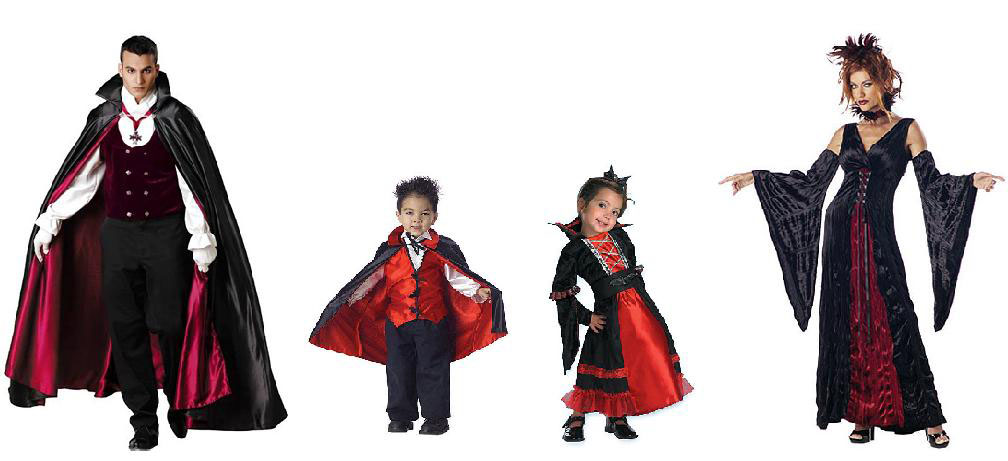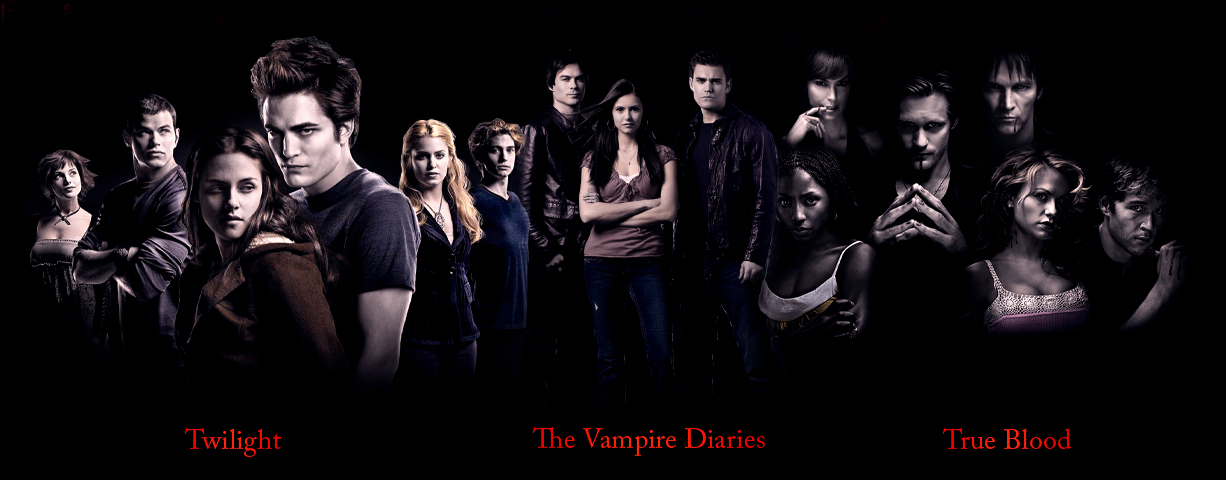
According to Kate Goodin in an article entitled "Parenting.com's Best Baby Names of 2010", polls show that
both Bella and Sookie have made it into the top list of baby girl names for 2010. Ironically enough, both
Bella and Sookie are the names of lead female roles in the vampire related television series True Blood
and vampire related movie Twilight. Vampires have become such a wide topic of discussion in society that
they have now begun to influence the actual identities given to children in present day American culture.

Vampires first hit the screen when "the first silent film-makers picked up a copy of Irish author Bram Stoker's 1897 horror novel," Dracula, which portrayed a vampire who would soon produce numerous "pale-faced progeny" (A Screen History of Vampires). Since then, vampires have transitioned in and out of popularity on the big screen. In past representations of vampires, they have been "things of fear and disgust," yet now they are known as creatures who "possess unearthly physical beauty" (Szaroleta & Zarate). Szaroleta and Zarate provide a glimpse of the vampire phenomenon according to eras. From the mid-1700s up through the 1950s, vampires were seen as bloodthirsty killers (Szaroleta & Zarate). After the 1950s up through 1975, vampires became more family friendly with depictions of vampires as more kind creatures (Szaroleta & Zarate). Bobby "Boris" Pickett's novelty song "The Monster Mash" reached number 1 on music charts in 1962 helping to develop the idea of the family friendly vampire even further (Szaroleta & Zarate). Beginning with "Interview with the Vampire" by Anne Rice, published in 1976, vampires slowly transitioned into sex symbols (Szaroleta & Zarate). Other sexualized vampire representations were seen in later movies and television including Love at First Bite (1979), The Lost Boys (1987), Buffy the Vampire Slayer movie and television series (1992, 1997-2003), and Van Helsing (2004) (Szaroleta & Zarate).
Although Charlaine Harris' novel series "The Southern Vampire" debuted in 2001, it was the HBO release of True Blood in 2008 based off of this series that stirred an even greater interest in vampires on television (southernvampires.com). Following this release, the CW television series The Vampire Diaries was introduced in 2009, based off of L.J. Smith's book series originally published in 1991 (vampirediaries.net). However, it was the 2005 novel "Twilight" by Stephenie Meyer that capitalized the multiple "series of vampire-centric books and films", and was later turned into a movie itself in 2008 (Szaroleta & Zarate). "The Vampire Diaries", "The Southern Vampire", and "Twilight" were all published before the release of their related television and movie media. Even though these books have progressively gained popularity, it is the release of their coinciding television series and movie series that seems to have caused the vampire phenomenon to explode.
True Blood, Twilight, and Vampire Diaries have all been introduced to television and cinema in post 9/11 American culture. It is possible that the growing popularity of vampires in the media is the result of a new mindset taken on in post 9/11 society. Post 9/11 society has created themes such as fear of death or fear of the "other" in American culture as a whole. Death and the "other" are both common components of vampire related media, because in many ways vampires stand as a symbol of death, and are represented in these media as the "other" because they are different from humans. Updegraff, Silver, and Holman conducted psychological research as to how people cope with trauma. Their findings showed that "search for meaning is a primary human motivation that enables individuals to retain hope in the face of adversity" (Updegraff, Silver, & Holman). Finding meaning includes having a better grasp on what death is, as well as getting over fears of death. If it is possible to get over a fear of death, the meaning to life will become much clearer. Although the answers might not be in vampire media specifically, True Blood, Twilight, and Vampire Diaries all provide close insight into these two subject areas.

Another possible reason for the vampire phenomenon is based off of the fact that sexuality is an ever-present theme in present day American culture. As stated earlier, we are currently in the vampire era in which vampires are used as sex symbols. In order to draw people in, a majority of the promotional images used to capture viewers are sexualized. Ironically, the vampires themselves are not always the character that is most highly sexualized. Instead, images of True Blood, Twilight, and Vampire Diaries portray the lead female role in a sexualized way. A study done on the appearance of women as sexualized objects in advertisements showed that "the pervasiveness of media images of highly sexualized women, but not men, is hypothesized to maintain men's dominance by designating women's bodies as property that can be evaluated, ogled, and touched at the whim of men's desire" (Stankiewicz & Rosselli). While the scene stills of female characters in these shows may not be sexualized, the promotional content for True Blood, Twilight, and Vampire Diaries all display women as sexualized objects from a voyeuristic viewpoint, which in turn, has the ability to draw people in to the vampire phenomenon.
As an avid watcher of True Blood, Twilight, and Vampire Diaries, the goal of my research is to discuss two explanations as to why the vampire phenomenon is thriving in present day American culture. I have seen all episodes of True Blood and Vampire Diaries. Also, I have read all four books of the "Twilight" series, and seen the two movies released in accordance with the first two novels. Although I am a fan of the two television series and Twilight movies and personally have a large amount of background knowledge on all three, my goal is to formulate an understanding as to why this fandom is so widespread. This research aims to discuss the vampire phenomenon as a response to post-9/11 culture, as well as a result of the sexualized images all three vampire related media portray.
a class taught by Bob Bednar in the Communication Studies Department at Southwestern University